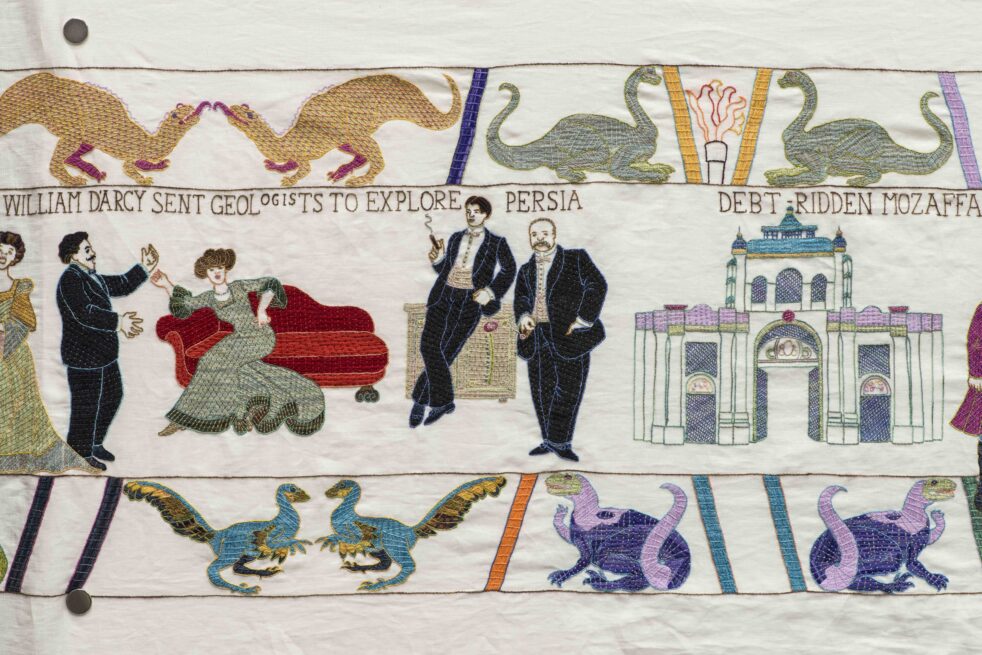The Museum of Design Atlanta (MODA) unveiled the “Threads of Change: Design & Data” exhibit on Feb. 9. This new display combines history and science with textile arts to communicate the ongoing effects of humanity on the world.
The highlight of the exhibit is the nearly 220-foot-long hand-embroidered tapestry that spans the entire museum and details the complete world history of oil. Filmmaker Sandra Sawatzky fabricated the “Black and Gold Tapestry” across nine years, amassing over 16,000 hours of work from the inception of the design in 2008. The tapestry was inspired by the “Bayeux Tapestry” and films including “Lawrence of Arabia.” A film of this scale would require an unprecedented budget, so Sawatzky turned to embroidery, her childhood hobby, to complete her goal. Laminated cards guide visitors through the tapestry and further the story shown across the 100% flax linen spread.
For psychology and neurology enthusiasts, the “Knitted Brains 1 and 2” by Karen Norberg is an incredible sculpture. Prior to the creation of modern brain imaging technology such as magnetic resonance imaging and MRIs, Norberg took the challenge of modeling the human brain using knitted yarn due to the similarity between heavy-yarn ruffles with the folds of a brain. The 1994 “Knitted Brain 1” is a complete representation of the brain’s neocortex in color-coded regions relating to their functions. The corpus callosum features a zipper to reveal the inside of the brain which is detailed in “Knitted Brain 2,” a current work in progress.
Knitted and crocheted strands of yarn draped across the entrance to the main gallery are impossible to miss as “Net-Work” by Adrian Baker epitomizes the vast interconnectedness of all life. The hanging pieces of yarn are the product of an ongoing community collaboration where visitors to the installation can spend some time knitting or crocheting their own pieces to add to the exhibit. As guests walk through the scattered thread, they are asked to consider how the web of communication between tree roots is similar to the communication between humans.
Twin sisters Margaret and Christine Wertheim combined their polarized backgrounds in science and art, respectively, to begin their response to the continued plastic pollution and global warming threats to coral reefs in 2005. Throughout the next 11 years, the Wertheims created the “Crochet Coral Reef” project alongside thousands of collaborators across the world to stitch yarn and recycled materials together. The four pieces on exhibit at MODA are exemplary models of their effort, integrating hyperbolic geometry via the millions of stitches applied.
The North Decatur Presbyterian Church took part in the Tempestry Project, a worldwide push to increase climate change awareness through textile arts. The 2017 project displays an entire year’s worth of measured daily high temperatures through different colors of knitted rows, which 11 members of the Church used to connect throughout 2020. This visual representation of temperatures is a unique medium to view the impacts of global warming from 1930 to 2019.
Four of Nathalie Miebach’s sculptures at MODA interpret devastating weather conditions throughout history including Hurricane Sandy, the Perfect Storm of Oct. 1991 and the San Diego floods of Jan. 2024. These intricate models present statistics from these events while taking the form of a tornado of toys, wood, roller coasters and more. The unsettling combination of each storm’s strength with vibrant colors including signs claiming “THE LAST RIDE” draws the attention of visitors to consider the destruction of these natural phenomena and the reconstruction of our societies in their wake.
Data regarding environmental and social issues is visually arranged on Bonnie Peterson’s “Geoscience Embroideries” quilts. Although the graphs look how they’re expected, a shocking amount of information is embroidered on the surrounding silk and velvet to force the observers to shift their focus.
MODA will host the Threads of Change: Design & Data exhibit from Feb. 9 until May 25, 2025.
